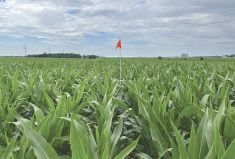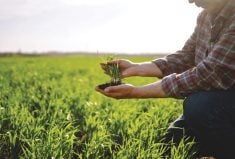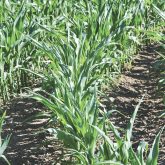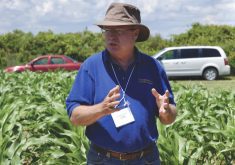What’s involved in a soil health assessment? And what makes soil “healthy” in the first place? Researchers at the Chinook Applied Research Association (CARA) in Oyen, Alta., are keen to answer these questions for western Canadian producers.
The association is launching a new lab in the CARA facilities that will collect and analyze soil samples to help producers improve soil health on their operations.
“Standard soil tests have primarily focused on the soil chemical composition. Recommendations generated from these analyses have been for applying soil amendments for increasing crop yields, but not for improving intrinsic soil conditions,” writes Yamily Zavala, a crop and soil health management specialist at CARA, in an overview of the topic geared to producers.
Read Also

Agronomists share tips for evaluating new crop products and tech: Pt. 3
With new products, new production practices and new technology converging on the agriculture industry at a frenetic pace in recent…
“Soil health assessments provide us with information about soil constraints beyond nutrient deficiency or excess,” Zavala says.
By now, most producers have likely heard of the Solvita test, which measures CO2 respiration over a 24-hour period in order to quantify microbial activity and potential nutrient availability in the soil. Producers can order Solvita test kits for use on their farms, and some labs include the Solvita test as an optional add-on to regular soil testing.
‘More complete’ package
But soil health tests go beyond the Solvita test. CARA’s soil health lab will combine the Cornell Soil Health Assessment and Soil Foodweb soil health testing protocols, which Zavala says will make for a “more complete” package than stand-alone tests like Solvita.
The lab will analyze physical indicators of soil health such as aggregate stability, compaction and texture, as well as biological activity.
A key test in the latter category is the “active carbon” test, an indicator of readily available food and energy sources for the soil microbial community. Small changes over time are easily detected by this test.
Another important biological test measures soil microbial respiration over a four-day period (as opposed to Solvita’s day-long incubation period) for metabolic activity of the soil microbial community.

Other tests will evaluate ratios of bacteria and fungi, nematodes, protozoa, mycorrhizae and other organisms. The presence of these microscopic creatures has important implications for soil health, as they are key to nutrient cycling and availability.
“These organisms are there in the soil, we just need to feed them properly,” says Zavala. “When you feed them properly, they start doing their job, which is to improve the soil so that conditions are better and microbial diversification can increase.”
Zavala is passionate about the need to look at the “whole package” of soil health in Western Canada.
“We’ve been looking at nitrogen or other deficiencies in the soil for years, but not in a holistic sense that can explain why the N is not efficient in the soil,” she says. “For example, if the soil is compacted, aggregation is affected and then microbiology is affected. When we see that aggregation stability is poor in the soil, that’s an indication that management changes need to be made.”
First things first
Not everyone is convinced producers should jump on the soil health bandwagon — at least before there’s enough data to link specific soil health parameters to management recommendations.
“We caution producers that we don’t really know how to use them, in terms of making recommendations for changing practices,” says Marla Riekman, a soil management specialist with Manitoba Agriculture.
Riekman is involved in a Manitoba Beef and Forage Initiative project looking at how continuous versus planned grazing affects soil health. She’s using North Dakota-based Agvise labs for soil testing on the project. Agvise uses the Solvita test and the Haney suite of soil health tests, which analyze chemical and biological soil data.
Some farmers, curious about how their farming practices affect the environment, are asking for soil health test information, says Riekman. But many farmers aren’t even doing general nutrient testing, which is the “first step” and the cheaper option, as complete soil tests, including soil health parameters, can quickly add up to US$100 to $150 per test.
“I fear producers are going to jump whole-hog into soil health testing when we don’t know how to make recommendations, and they’ll be wasting money,” she says.
John Heard, soil fertility specialist with Manitoba Agriculture, calls himself a “traditionalist” when it comes to soil testing, “and traditional soil testing is meant to produce soil fertility recommendations,” he says. “Until they’re properly calibrated, soil health tests may serve as a distraction from doing routine, proven soil tests with proven recommendations.”
More data needed
Heard and Riekman agree that more data for soil types across Western Canada is needed before specialists can express more confidence in making soil health improvement recommendations.
Nobody contests the need for more soil health data; Zavala says the CARA lab will build up baseline soil health indicators for western Canadian soil types over time. “The more soil samples farmers send to the lab, the more information they’ll have for creating their own benchmarks,” she says.
The information will also be used for calibrating and standardizing soil health lab protocols for adjusting them to the Canadian soils and climatic conditions.
Riekman says producers can find out a good deal about soil health on their own without chemical analysis, particularly if they’re willing to get their hands dirty.
“If you get down into the soil, you can see a lot of what’s going on that might indicate whether your soil is healthy — for example, seeing what the aggregate structures look like, whether there’s a compaction problem or drainage issues,” she says.
Riekman is involved in a Canadian Foodgrains Bank project promoting exactly this approach to smallholder farmers in East Africa.
“There are labs there, but they don’t do soil health testing,” says Riekman. “Instead, we’ve created a hands-on assessment tool, like a flow chart to check off, that teaches farmers how to look at soil and evaluate it on their own.”
These, she says, are conservation agriculture principles that can just as easily be applied in Western Canada as East Africa.
A brief guide to soil health tests
- Soil respiration tests, such as the Solvita test (below), look at carbon dioxide (CO2) emissions from the soil to measure soil health.
- The Cornell Soil Health Assessment evaluates soil health indicators for biological, physical, chemical and other soil constraints.
- The Haney Test looks at biological and chemical indicators of soil properties. This test considers C to N ratios to help provide NPK fertilizer recommendations and suggest cover crop ratios of legumes to grasses.
Source: “Soil health assessment: an introduction to farmers,” Yamily Zavala, CARA
A Solvita field test kit was used to look at soil biological activity (see image below). The left paddle is from a conservation agriculture (CA) field and the right paddle from the non-CA field alongside. The CA field has higher microbial activity, as indicated by the lighter (more yellow, Zavala explains, low) colour of the paddle. Riekman thinks the increase isn’t due to the decrease in tillage, but due to leaving more crop residue on the field to protect the soil from erosion and preserve moisture, providing additional “food” for the microbes and making them respire more.

















